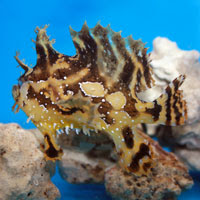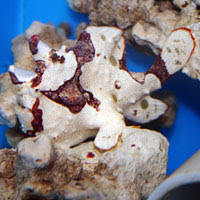Melisa here. Well, it is that time of the year again. It’s a bit chilly these days. What better to do than snuggle with the one you love or find someone to love…right?
 The Anglers and frogfish that are commonly kept in our aquariums have much less complicated rituals. Just before mating (usually 8-12 hours before), the females of many common types will begin to fill with eggs, typically 40,000 to 180,000! Their abdomens become distended, making them quite buoyant. When the male comes along he nudges the female’s abdomen, stimulating her to move to the surface where spawning occurs. The eggs are usually released as an egg raft or veil that drifts along for a few days before dropping to the sea floor after the embryos hatch. Post-planktonic frogfish (1-2 months old) take on the appearance of a perfect tiny Frogfish, but often display bright defensive colors!
The Anglers and frogfish that are commonly kept in our aquariums have much less complicated rituals. Just before mating (usually 8-12 hours before), the females of many common types will begin to fill with eggs, typically 40,000 to 180,000! Their abdomens become distended, making them quite buoyant. When the male comes along he nudges the female’s abdomen, stimulating her to move to the surface where spawning occurs. The eggs are usually released as an egg raft or veil that drifts along for a few days before dropping to the sea floor after the embryos hatch. Post-planktonic frogfish (1-2 months old) take on the appearance of a perfect tiny Frogfish, but often display bright defensive colors!
Some species actually tend to the eggs, protecting the clutch until they hatch. Lophiocharon trisignatus males attach the egg clusters to their bodies until they hatch. Some species hold the eggs not only to protect them, but also to lure prey closer with the eggs as a prospective meal for the clueless prey!
Deep sea anglerfish of the superfamily Ceratioidea probably have the most interesting way to find the” love of their life,” to say the least.
When scientists first started studying ceratioid anglerfish they were confused why all they appeared to capture were female anglerfish. It was also noted that most of these anglerfish that were studied had some type of parasite attached to them. It was later revealed that the “parasite” was actually what remained of the male anglerfish. With some further investigation scientists were able to tap into the secret lives of these anglerfish.
At birth the males are programmed to detect scents in the water. They immediately begin their search for a female in the deep dark depths of the ocean. As they mature, the males digestive system shuts down, making the males incapable of feeding themselves. If he does not find a female he will die. Assuming he finds a female he takes a big comp and attaches himself for life. The male anglerfish releases an enzyme that fuses his body with hers. From the moment they are one the male becomes an autotroph living off the female. As time goes by the male begins to degenerate, leaving only lump with is gonads enclosed to release sperm when the female releases her eggs. This extreme mating ritual assures that when the female is ready to release eggs they will be fertilized.
If you know of any other bazaar mating rituals in the fishy world I would love to hear about them.
Until next time,
Patty
 That Fish Blog – Aquarium Advice and Information
That Fish Blog – Aquarium Advice and Information






